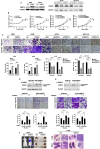PRMT5 promotes colorectal cancer growth by interaction with MCM7
- PMID: 33675123
- PMCID: PMC8034445
- DOI: 10.1111/jcmm.16436
PRMT5 promotes colorectal cancer growth by interaction with MCM7
Abstract
Protein arginine methyltransferase 5 (PRMT5) is a type of methyltransferase enzyme that can catalyse arginine methylation of histones and non-histone proteins. Accumulating evidence indicates that PRMT5 promotes cancer development and progression. However, its function in colorectal cancer (CRC) is poorly understood. In this study, we revealed the oncogenic roles of PRMT5 in CRC. We found that PRMT5 promoted CRC cell proliferation, migration and invasion in vitro and in vivo. We identified minichromosome maintenance-7 (MCM7) as the direct PRMT5-binding partner. A co-immunoprecipitation (co-IP) assay indicated that PRMT5 physically interacted with MCM7 and that the direct binding domain was located between residues 1-248 in MCM7. In addition, our results from analysis of 99 CRC tissues and 77 adjacent non-cancerous tissues indicated that the PRMT5 and MCM7 expression levels were significantly higher in CRC tissues than in control tissues, which was further confirmed by bioinformatic analysis using TCGA and GEO datasets. We also found that MCM7 promoted CRC cell proliferation, migration and invasion in vitro. Furthermore, we observed that increased PRMT5 expression predicted unfavourable patient survival in CRC patients and in the subgroup of patients with a tumour size of ≤5 cm. These data suggested that PRMT5 and MCM7 might be novel potential targets for the treatment of CRC.
Keywords: MCM7; PRMT5; colorectal cancer.
© 2021 The Authors. Journal of Cellular and Molecular Medicine published by Foundation for Cellular and Molecular Medicine and John Wiley & Sons Ltd.
Conflict of interest statement
All the authors declare no conflict of interest.
Figures




Similar articles
-
PRMT5 functionally associates with EZH2 to promote colorectal cancer progression through epigenetically repressing CDKN2B expression.Theranostics. 2021 Jan 27;11(8):3742-3759. doi: 10.7150/thno.53023. eCollection 2021. Theranostics. 2021. PMID: 33664859 Free PMC article.
-
Targeting protein arginine methyltransferase 5 inhibits colorectal cancer growth by decreasing arginine methylation of eIF4E and FGFR3.Oncotarget. 2015 Sep 8;6(26):22799-811. doi: 10.18632/oncotarget.4332. Oncotarget. 2015. PMID: 26078354 Free PMC article.
-
NAA40 contributes to colorectal cancer growth by controlling PRMT5 expression.Cell Death Dis. 2019 Mar 11;10(3):236. doi: 10.1038/s41419-019-1487-3. Cell Death Dis. 2019. PMID: 30858358 Free PMC article.
-
Protein arginine N-methyltransferase 5 in colorectal carcinoma: Insights into mechanisms of pathogenesis and therapeutic strategies.Biomed Pharmacother. 2022 Jan;145:112368. doi: 10.1016/j.biopha.2021.112368. Epub 2021 Nov 15. Biomed Pharmacother. 2022. PMID: 34794114 Review.
-
The PRMT5 arginine methyltransferase: many roles in development, cancer and beyond.Cell Mol Life Sci. 2015 Jun;72(11):2041-59. doi: 10.1007/s00018-015-1847-9. Epub 2015 Feb 7. Cell Mol Life Sci. 2015. PMID: 25662273 Free PMC article. Review.
Cited by
-
DNA replication: Mechanisms and therapeutic interventions for diseases.MedComm (2020). 2023 Feb 5;4(1):e210. doi: 10.1002/mco2.210. eCollection 2023 Feb. MedComm (2020). 2023. PMID: 36776764 Free PMC article. Review.
-
A DNA replication-independent function of pre-replication complex genes during cell invasion in C. elegans.PLoS Biol. 2022 Feb 22;20(2):e3001317. doi: 10.1371/journal.pbio.3001317. eCollection 2022 Feb. PLoS Biol. 2022. PMID: 35192608 Free PMC article.
-
Tadalafil increases the antitumor activity of 5-FU through inhibiting PRMT5-mediated glycolysis and cell proliferation in colorectal cancer.Cancer Metab. 2022 Dec 6;10(1):22. doi: 10.1186/s40170-022-00299-4. Cancer Metab. 2022. PMID: 36474242 Free PMC article.
-
Clinicopathological and Prognostic Significance of PRMT5 in Cancers: A System Review and Meta-Analysis.Cancer Control. 2021 Jan-Dec;28:10732748211050583. doi: 10.1177/10732748211050583. Cancer Control. 2021. PMID: 34758643 Free PMC article.
-
Multiomics profiling of the expression and prognosis of MCMs in endometrial carcinoma.Biosci Rep. 2021 Dec 22;41(12):BSR20211719. doi: 10.1042/BSR20211719. Biosci Rep. 2021. PMID: 34859821 Free PMC article.
References
-
- Siegel RL, Miller KD, Fuchs HE, et al. Cancer Statistics, 2021. CA Cancer J Clin. 2021;71:7‐33. - PubMed
-
- Dekker E, Tanis PJ, Vleugels JLA, et al. Colorectal cancer. Lancet. 2019;394:1467‐1480. - PubMed
-
- Lasry A, Zinger A, Ben‐Neriah Y. Inflammatory networks underlying colorectal cancer. Nat Immunol. 2016;17:230‐240. - PubMed
-
- Branscombe TL, Frankel A, Lee JH, et al. PRMT5 (Janus kinase‐binding protein 1) catalyzes the formation of symmetric dimethylarginine residues in proteins. J Biol Chem. 2001;276:32971‐32976. - PubMed
Publication types
MeSH terms
Substances
Grants and funding
- LY17H160034/Zhejiang Provincial Natural Science Foundation of China
- LY19H030012/Zhejiang Provincial Natural Science Foundation of China
- LY21H160040/Zhejiang Provincial Natural Science Foundation of China
- 81672342/National Natural Science Foundation of China
- 81772527/National Natural Science Foundation of China
LinkOut - more resources
Full Text Sources
Other Literature Sources
Medical

